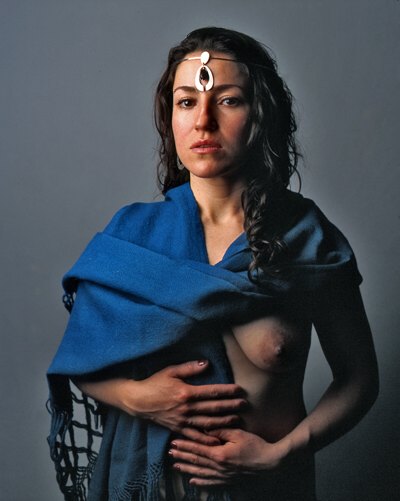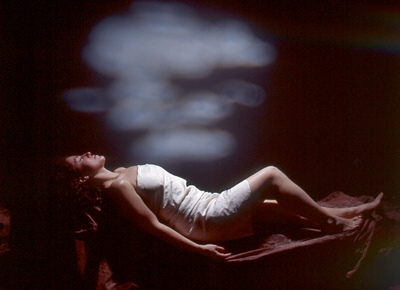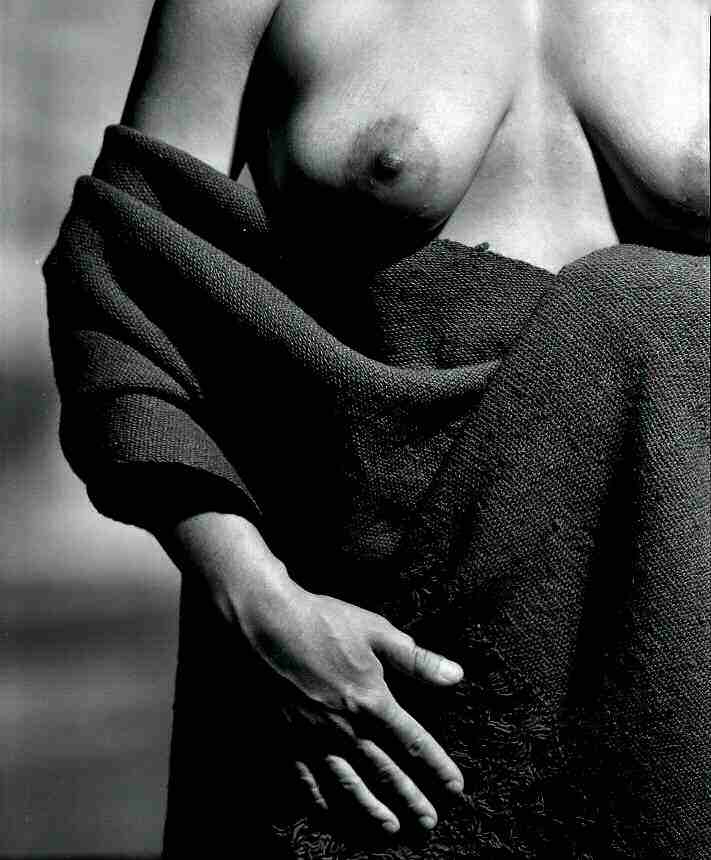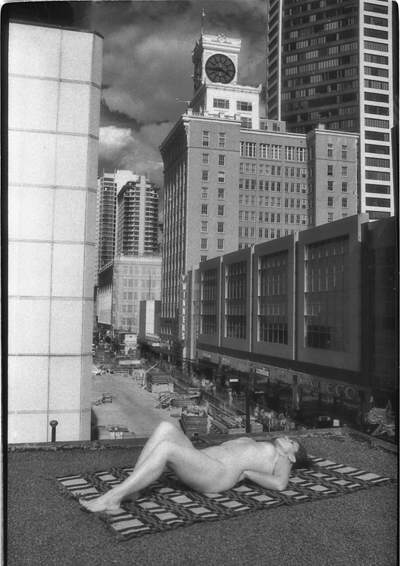MEXICAN NOSTALGIA

by
ALEX WATERHOUSE-HAYWARD
______________
Alex Waterhouse-Hayward
is a distinguished Canadian photographer and regular contributor
to Arts & Opinion. For more of Alex's photography,
visit his website at:
www.alexwaterhousehayward.com

I met Nicte-Ha only once sometime
in 1954. I have no memory of what she looked like except that
she was exotic. The jewelry I had made of Sterling silver
and the seed in the middle is from the Mexican tree called
the Colorín. I planted the tree in my front yard around
1972 and when it flowered I kept the seeds to make the jewelry
which consists of this necklace, earings and a ring. The Mexican
rebozo is from a collection I inherited from my mother.
Some concepts are
so obvious that one does not give them much thought. It came
to me only recently when I felt nostalgia for Mexico. In a flash
I realized that my feeling had all to do with not being in Mexico
and that Vancouver rain was making me feel blue. The reverse
of this idea is what stifles me when I want to take photographs
in Vancouver. I miss European cemeteries, Mexican baroque churches
and the birds of the Argentine pampa. If I were living in Venice
right now I would be looking for a beautiful Canadian woman
at Piazza San Marco. I would try to convince her to pose for
me undraped under my Vancouver Umbrella Shop umbrella.
 It
was around 1952 when I was living in Buenos Aires that my mother
went on an exploratory trip to Mexico. She returned with magical
stories of volcanoes, exotic fruits (mangoes), Aztec pyramids
and of ancient churches. She brought with her a blood-red rebozo
made of rough cotton that has been part of my life (and in many
of my photographs) since. We moved.
It
was around 1952 when I was living in Buenos Aires that my mother
went on an exploratory trip to Mexico. She returned with magical
stories of volcanoes, exotic fruits (mangoes), Aztec pyramids
and of ancient churches. She brought with her a blood-red rebozo
made of rough cotton that has been part of my life (and in many
of my photographs) since. We moved.
In those early 1950s,
Mexico was experiencing a golden age of cinema and art. Two
Mexican muralists, David Alvaro Siqueiros and Diego Rivera,
were still alive. My mother and her Mexican friends often went
to parties or gave parties at home. That is how I met Rivera
and Alma Reid, an American journalist who had been the inspiration
for one of the loveliest of Mexican songs, “La Peregrina,”
which was a love story based on her relationship with Yucatán
governor Felipe Carrillo Puerto, who was assassinated a few
days before their marriage. In one of those festive evenings
I saw the ugly chubby man that was Diego Rivera. I was more
interested in a beautiful woman in native clothing. Her name
was Nicte-Ha who told everybody she was a Mayan princess. I
was too young to appreciate or understand my good luck.

La Santa Muerte patron saint
of Mexican drug traffickers. My nostalgia for this figure
comes from my enjoyment of the novels and poetry books of
Mexican writer Homero Aridjis.
 In
those years I rejected anything that was Mexican, especially
those “terrible” Mexican movies based on the wonderful
stories of the mysterious B. Traven. But I enjoyed the rumours
that Mexican actress María Felix (reputed to have had
affairs with both Rivera and Frida Kahlo, and with Mexican president
Miguel Alemán) would go to Paris (some said Switzerland)
and would sleep for a month in a secret treatment that made
her look young again. It was around 1960 that my mother took
me to see Oscar Wilde’s Lady Windermere’s Fan
in a Mexican stage production in Spanish that featured the beautiful
Dolores del Río. The performance went over my head and
all that remained in my memory was her wonderful voice.
In
those years I rejected anything that was Mexican, especially
those “terrible” Mexican movies based on the wonderful
stories of the mysterious B. Traven. But I enjoyed the rumours
that Mexican actress María Felix (reputed to have had
affairs with both Rivera and Frida Kahlo, and with Mexican president
Miguel Alemán) would go to Paris (some said Switzerland)
and would sleep for a month in a secret treatment that made
her look young again. It was around 1960 that my mother took
me to see Oscar Wilde’s Lady Windermere’s Fan
in a Mexican stage production in Spanish that featured the beautiful
Dolores del Río. The performance went over my head and
all that remained in my memory was her wonderful voice.
It was in Mexico
that I learned to take photographs. It was at the University
of the Americas in 1964 that I obtained a first prize in photography.
At the time, I didn’t realize that the judge who had signed
my diploma was noted Mexican painter Rufino Tamayo.
In 1968 I married
my Canadian wife Rosemary (New Dublin, Ontario) and by 1975
we decided that we and our two Mexican born daughters had had
enough of Mexico: its uncertainty and failing economy, corrupt
politicians and policeman. The ever present smog prevented us
from seeing those two volcanoes, Ixtacciuatl and Popocatepetl
that had so charmed my mother. I lusted after chocolate that
did not contain cinnamon, 12 issues of the National Geographic
(either pilfered or lost by the Mexican postal system), fresh
air, clean water and a steady 110 voltage.

There are a few accepted
spellings for this famous Mexican volcano, Ixtaccihuatl,
known as la mujer dormida or the sleeping woman.
This volcano and her mate Popocatepetl are seen sometimes
in Mexico on those rare clear days.
While I now receive
my 12 issues of the Geographic, and we have good electricity,
relatively fresh air and clean water in Vancouver, I have come
to realize that our politicians are not really all that better
and that our police force is not squeaky clean. I now long for
Mexican chocolate bars with luscious cinnamon, hand made tortillas,
and houses and churches that are older than 100 years.
I miss Mexico’s
two changing seasons. During the rains the mountains are green.
In the dry season they become rich ocher and brown. But most
of all I miss the heat, the smells and a sense that when one
walks the streets of Mexico City or in the countryside, that
one is passing through invisible ghosts -- Aztecs, Mayans, Olmecs,
Spanish conquistadors, Zapatista soldiers; and in the port city
of Veracruz I often imagined the ghost of a young captain, Robert
E. Lee, who had landed there and master-planned the siege of
the city in 1847 in the Mexican-American War.
In the early 1960s
I lived on Tamaulipas Street in Mexico City. I did not know
then that the house where American photographer Edward Weston
had lived in the 1920s was a block away. It was on the azotea
(roof) of that house, under a hot Mexican sun, that Weston had
often photographed Tina Modotti in the nude . She became a photographer
in her own right. When she was expelled in 1930 for her leftist
leanings, she gave her 4 x 5 camera (a gift from Weston) to
a young Manuel Álvarez Bravo (1902-2002). It was in 1986
that Bravo took what I believe is the most wonderfully erotic
photograph I have ever seen – a shot suffused with the
heat and dramatic light of Mexico. I can smell the land when
I’m in the presence of this photograph. I can imagine
the proud face of the woman even if it is not part of the photograph.
Until his death, Bravo’s daily routine began with breakfast
(coffee and bread) and then going to his studio to photograph
a female nude.

This is my version of Manuel
Alvarez Bravo's photograph. Since I didn't have a hot Mexican
sun I had to make do with my fake projected clouds and the
use of a spotlight to imitate the sun. It was exciting to
try to get into Bravo's head and determine where he had
placed his camera.
When I met Ivette
Hernanez (she works as a construction worker in Vancouver) some
6 months ago and found out she was from the city of León
in Guanajuato (Mexico), I immediately told her of my project
to project on her my visions of Mexican nostalgia that would
transform her into a Mayan princess, La Malinche or as the Spaniards
called the woman who translated for Hernan Cortés, Doña
Marina, la Santa Muerte (the patron saint of drug traffickers),
a Mexican cook with a device, a molinillo, to froth
up Mexican chocolate, the volcano Ixtaccihuatl (the sleeping
woman), María Felix asleep in Paris, Dolores de Río
as Lady Windermere and even a Dolores del Río as the
Mexican woman in the John Ford film “The Fugitive”
with Henry Fonda and Pedro Armendáriz.
 As
for the picture of Hernandez dressed in my Puerto de Liverpool
(sort of a Mexican Eaton’s) suit at a Remington typewriter
(my grandmother bought it in New York City around 1930), it
represents a more obscure Mexican nostalgia. Sometime in the
beginning of the 1970s we received a huge electric bill from
the Mexican power company. It was obviously a mistake. We went
to downtown Mexico City and under the portales (covered
arched sidewalks) we found an evangelista. Evangelistas
(always men) compose letters for those who cannot read or write.
They write wonderful love letters if you’re not a Cyrano
but best of all they master bureaucratic Spanish. This is what
we needed to get our money back. And we did.
As
for the picture of Hernandez dressed in my Puerto de Liverpool
(sort of a Mexican Eaton’s) suit at a Remington typewriter
(my grandmother bought it in New York City around 1930), it
represents a more obscure Mexican nostalgia. Sometime in the
beginning of the 1970s we received a huge electric bill from
the Mexican power company. It was obviously a mistake. We went
to downtown Mexico City and under the portales (covered
arched sidewalks) we found an evangelista. Evangelistas
(always men) compose letters for those who cannot read or write.
They write wonderful love letters if you’re not a Cyrano
but best of all they master bureaucratic Spanish. This is what
we needed to get our money back. And we did.
I have attempted
to satisfy some of my nostalgia for Mexico by going to Mexico.
With my wife Rosemary we have taken our granddaughter Rebecca,
11-years-old, to Guanajuato, Morelia and most recently Mérida
in Yucatán. Perhaps some day she will feel a nostalgia
for Chichen-Itzá, the humid heat of Mérida and
might even become curious to find out about Frida Kahlo, who
is on the wall of that Mérida restaurant when I photographed
her in 2007.
As for Ivette Hernandez,
she has a face and way about her that with very few props she
becomes my nostalgia for Mexico in flesh and blood.

This picture mimics a photograph
that Edward took of Tina Modotti on the roof of his house/studio.
My version is on the roof of my downtown studio.